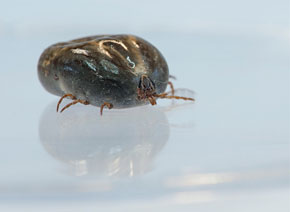
Léo RamosStar tick: feeding guaranteed by a mechanism in its saliva that prevents blood clottingLéo Ramos
A protein found in the salivary gland of the star tick (Amblyomma cajennense) showed promising antitumor and anticoagulant activity in tests. A research group coordinated by Professor Ana Marisa Chudzinski-Tavassi, director of the Butantan Institute’s Biochemistry Laboratory and a member of the Research, Innovation and Dissemination (RIDC) program of FAPESP made the discovery. “The protein, called Amblyomin-X, kills only tumor cells, and poses no risk to the healthy ones,” she says. The researchers mapped how the cells died and the mechanisms involved in the action. The Amblyomin-X protein inhibits activity by proteasome, an enzyme complex whose function is to eliminate undesirable proteins in order to maintain cellular integrity. “We studied the protein’s mode of action to induce programmed cell death, a process known as apoptosis.”
The next steps are the preclinical tests, which will be performed by two Brazilian companies according to international standards of evaluation, including the toxicity of the recombinant protein and the dose that could be used to treat patients. This phase is expected to last about eight months. “If everything goes according to plan, the tests in people will be released after this step,” says Fernando Castro Marques, president of União Química, the pharmaceutical company research partner. The expectation is that one potential focus of the drug, in addition to melanoma, would be pancreatic and renal cancer. “The action in pancreatic cancer is the one that interests us the most, because there is currently no medical treatment for this type of tumor,” he says. In October, the Butantan researchers, representatives of the company and FAPESP met with the National Health Monitoring Agency (ANVISA) to address the steps required for product registration. The three parties are the patent holders of the new molecule. It is anticipated that by the beginning of 2015 a new plant will have been built in Brasilia for production of the new molecule. União Química has an industrial complex located there.
The research began in 2000 with the biologist Simone Simons’s study of ticks. “As they are hematophagous and the blood must remain unclotted in order for them to feed themselves, we decided to study the anticoagulation mechanism found in the saliva of the star tick,” says Chudzinski-Tavassi, who is also pursuing a similar line of research on the anticoagulants present in leeches. The difficulty of biochemically characterizing the saliva components of the mite led researchers to opt to analyze the genes expressed in the salivary gland. “We analyzed more than 2,000 genes to see whether there were any that could translate a protein inhibitor of factor X (10) coagulation, which is essential to thrombin formation, the key enzyme for this process.” Translation is the process of protein synthesis or manufacture.
Plasma Inhibitor
According to Chudzinski-Tavassi, the pharmaceutical companies, are looking for a new anticoagulant drug that targets factor X (10), which can reduce the laboratory time required for conventional anticoagulation therapy. “We identified a clone that could be used to produce a molecule with factor X (10) inhibitory activity,” she says. The recombinant protein was produced from this clone by using an expression system in bacteria, and an analysis of its activity in the blood proved its effectiveness as an anticoagulant. The biochemical and structural characterization of the protein we obtained revealed similarities to a plasma inhibitor known as TFPI (tissue factor pathway inhibitor), which helps control blood clotting. “The scientific literature was already discussing the role of this inhibitor in cell proliferation.” Therefore researchers decided to test the recombinant protein in cells present in blood vessels as well as in cultured tumor cells. “We were surprised by the results because treatment with the protein kept the normal cells intact, but killed the tumor cells,” she says. Thus, the focus of the research was extended to the selective activity of the new molecule against tumor cells.
The next step was to test the recombinant protein in vivo. Tests were performed on two groups of mice with melanoma, the most serious type of skin cancer. The untreated animals developed tumors and died at about one month of age. The melanoma disappeared in the group receiving the protein for 42 days. By early 2000, the Center for Applied Toxinology of the Butantan Institute was already one of the 10 RIDCs created by FAPESP and maintained a partnership with the Biolab-Sanus laboratories, União Química and Biosintética. União Química was interested in the new molecule and filed the patent in Brazil, extending it to Europe, Asia and the United States. “We engaged a biotechnology company in the United States to construct, through genetic engineering, a synthetic gene and a new system of molecular expression in order to increase the production yield,” says Marques.
The project that began in 2000, but only started to focus on antitumors in 2005, now brings together a group of eight researchers from the Biochemistry laboratory, in addition to colleagues from the University of São Paulo (USP), such as Oncology Professor Roger Chammas and José Jukemura, a specialist in pancreatic medicine, both of the School of Medicine, and Professor Eduardo Reis, of the Chemistry Institute, who works in genomics and molecular biology. Selected by the Technology Fund (Funtec) of the Brazilian National Bank for Economic and Social Development (BNDES), the project will receive R$18 million that will be allocated to the Butantan Institute and the São Paulo Institute for Technological Research (IPT) to map a route for phased-in production of the recombinant protein and to do an economic analysis for installation of a factory for the industrial production of the molecule.
Projects
1. Center for Applied Toxinology; Grant Mechanism Research, Innovation and Dissemination Center (RIDC); Coordinator Hugo Armelin – Butantan Institute; Investment R$ 1,000,000 per year for the entire RIDC (FAPESP).
2. Mechanisms of action of Amblyomin-X in different normal and tumor cell lines (nº 2005/50560-6); Grant Mechanism Regular Line of Research Project Award; Coordinator Ana Marisa Chudzinski Tavassi – Butantan Institute; Investment R$ 227,833.93 (FAPESP).
3. Evaluation of the pro-apoptotic mechanism of action of Amblyomin-X (nº 2010/52669-3); Grant Mechanism Regular Line of Research Project Award; Coordinator Ana Marisa Chudzinski Tavassi – Butantan Institute; Investment R$ 249,786.30 (FAPESP).
